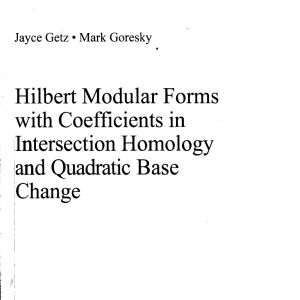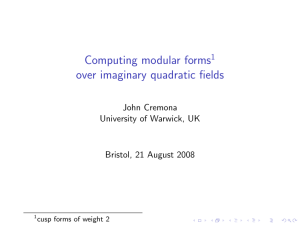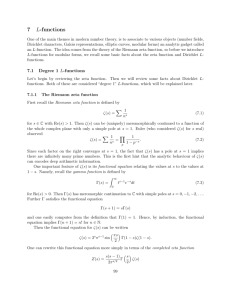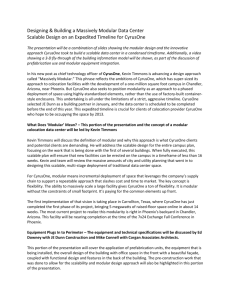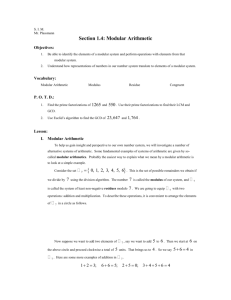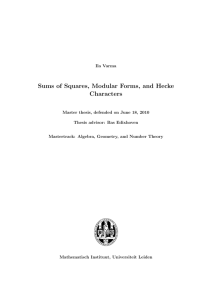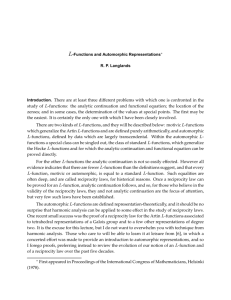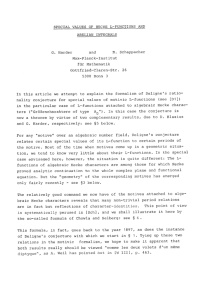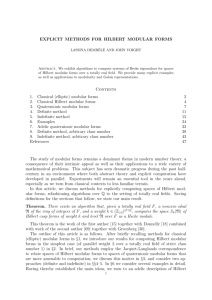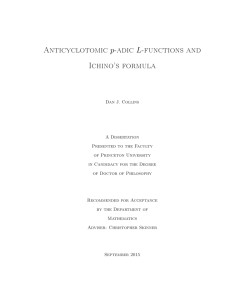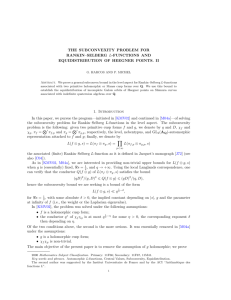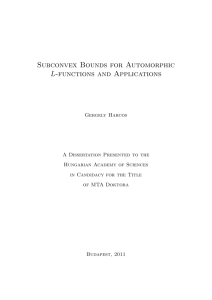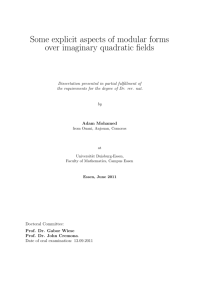MODULAR FORMS AND L-FUNCTIONS: A CRASH COURSE The
advertisement
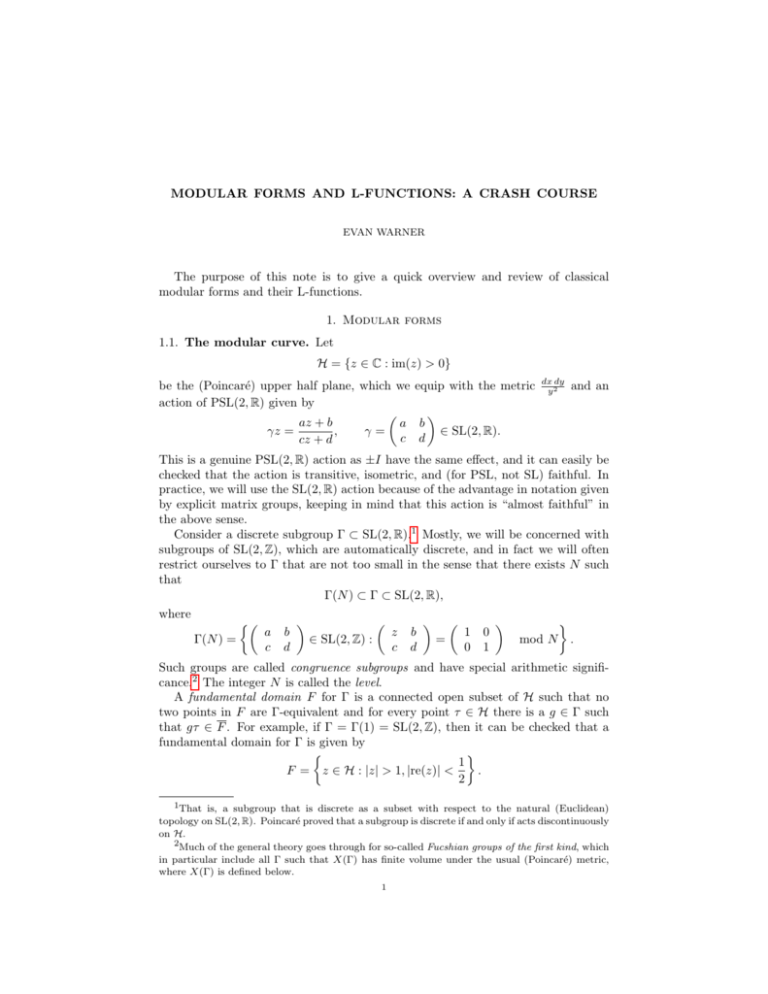
MODULAR FORMS AND L-FUNCTIONS: A CRASH COURSE
EVAN WARNER
The purpose of this note is to give a quick overview and review of classical
modular forms and their L-functions.
1. Modular forms
1.1. The modular curve. Let
H = {z ∈ C : im(z) > 0}
be the (Poincaré) upper half plane, which we equip with the metric
action of PSL(2, R) given by
az + b
a b
,
γ=
∈ SL(2, R).
γz =
c d
cz + d
dx dy
y2
and an
This is a genuine PSL(2, R) action as ±I have the same effect, and it can easily be
checked that the action is transitive, isometric, and (for PSL, not SL) faithful. In
practice, we will use the SL(2, R) action because of the advantage in notation given
by explicit matrix groups, keeping in mind that this action is “almost faithful” in
the above sense.
Consider a discrete subgroup Γ ⊂ SL(2, R).1 Mostly, we will be concerned with
subgroups of SL(2, Z), which are automatically discrete, and in fact we will often
restrict ourselves to Γ that are not too small in the sense that there exists N such
that
Γ(N ) ⊂ Γ ⊂ SL(2, R),
where
a b
z b
1 0
Γ(N ) =
∈ SL(2, Z) :
=
mod N .
c d
c d
0 1
Such groups are called congruence subgroups and have special arithmetic significance.2 The integer N is called the level.
A fundamental domain F for Γ is a connected open subset of H such that no
two points in F are Γ-equivalent and for every point τ ∈ H there is a g ∈ Γ such
that gτ ∈ F . For example, if Γ = Γ(1) = SL(2, Z), then it can be checked that a
fundamental domain for Γ is given by
1
.
F = z ∈ H : |z| > 1, |re(z)| <
2
1That is, a subgroup that is discrete as a subset with respect to the natural (Euclidean)
topology on SL(2, R). Poincaré proved that a subgroup is discrete if and only if acts discontinuously
on H.
2Much of the general theory goes through for so-called Fucshian groups of the first kind, which
in particular include all Γ such that X(Γ) has finite volume under the usual (Poincaré) metric,
where X(Γ) is defined below.
1
2
EVAN WARNER
It is useful to note that Γ(1) is generated by the elements
1 1
0 −1
T =
and S =
,
0 1
1 0
which often makes the full modular group Γ(1) easy to study. Geometrically, T
represents a shift to the right by 1, while S represents inversion about the unit
circle followed by reflection about the imaginary axis.
We can change variables
z−i
z 7→
z+i
to bring H to the (Poincaré) disc
D = {z : |z| < 1}.
This change of variables makes evident the symmetry between all the boundary
points, which consist of points of the real line R, which map to {z : |z| = 1} \ {1},
and the point at infinity, which maps to 1. If we draw the image of a fundamental
domain for Γ in D, we see several points at which this image seems to hit the
boundary in a narrow point. We would like to characterize these points of the
boundary, which are called cusps. The correct definition is as follows: a cusp is a
point s ∈ R ∪ {∞} that is fixed by a parabolic element of Γ.3 Since we will shortly
be taking a quotient of H by Γ, we more commonly let the term cusp refer to a
Γ-orbit of such points. Thus for the full modular group Γ(1) the cusps are precisely
Q ∪ {∞} under the former definition, or the singleton set {Q ∪ {∞}} under the
latter (because SL(2, Z) is transitive on Q ∪ {∞}). We therefore say that Γ(1) has
one cusp. By restricting to congruence subgroups4, we ensure that there exist only
finitely many cusps.
Let
H∗ = H ∪ {cusps of Γ},
where we take the first definition of cusp, and topologize H∗ as follows: around
every point of H, we take the induced (Euclidean) topology. Around each cusp
s ∈ R we take as a neighborhood basis the set of all sets of the form
{z : |z − (s + ir)| < r} ∪ {s}, r ∈ R+ .
This is the usual open ball with radius r tangent to the real axis at s, together with
the point s itself. Around the point ∞, if it is a cusp, we take as a neighborhood
basis the set of all sets of the form
{z : |re(z)| > R},
R ∈ R+ .
This is not the topology induced by the Euclidean topology on C; instead, we have
constructed a topology so that the set of all cusps (in the first sense) is discrete.
Hausdorffness may be easily checked.
Set
X(Γ) = Γ \ H∗
and give X(Γ) the quotient topology. We will put charts on X(Γ) which will make
it into a Riemann surface – the compactified modular curve. Around points with
“trivial” stabilizer (actually, the stabilizer is ±I), we put ordinary charts, inherited
from H. Fortunately, only finitely many non-cusps will not have trivial stabilizer;
3Recall that a parabolic element is an element of trace two that is not equal to ±I.
4or Fucshian groups of the first kind, more generally.
MODULAR FORMS AND L-FUNCTIONS: A CRASH COURSE
3
we call these points elliptic points.5 The stabilizer at an elliptic point is always
cyclic. In order to put a legitimate chart around an elliptic point, we have to “mod
out” by this stabilizer, which we do by stretching an ordinary chart appropriately.
In detail, we map a neighborhood of an elliptic point τ to the origin via
z−τ
,
z 7→
z−τ
then stretch by z 7→ z n , where n is the order of the stabilizer of τ , then take the
pullback of the ordinary chart around the origin under the composition of the two
maps. Around a cusp, which without loss of generality we can consider to be the
point ∞, we note that the stabilizer under Γ is isomorphic to Z, generated by
z 7→ T n z for some n. In order to put a legitimate chart around ∞, we again have
to “mod out” by this stabilizer, which we do by mapping z 7→ e2πiz/n and pulling
back the usual charts around the origin.6
The result is a compact Riemann surface X(Γ), the simplest example of a
Shimura variety and our basic analytic object.
1.2. Aside: the modular curve and elliptic curves. Modular curves for various arithmetically interesting congruence subgroups are moduli spaces for – that
is, they parametrize in a certain sense – elliptic curves with level structure. This is
easiest to see in the case of Γ(1): an elliptic curve over C is a complex torus, hence
can be described as C/Λ where Λ is a nondegenerate lattice in the complex plane.
Two elliptic curves are isomorphic if and only if their corresponding lattices are
homothetic. Quotienting out by homotheties can be achieved by bringing each Λ
into a standard form (generated by the elements of {1, τ }, where τ ∈ H), and each
nondegenerate lattice has an automorphism group of precisely SL(2, Z). Therefore
we have a bijection
{elliptic curves/isomorphism} ↔ Γ(1) \ H.
The compactified modular curve X(Γ(1)) adds at the cusp the “degenerate elliptic
curve” with zero discriminant.
This is generalized as follows. Let
a b
a b
∗ ∗
Γ0 (N ) =
∈ Γ(1) :
=
mod N
c d
c d
0 ∗
and
a b
a b
1
∈ Γ(1) :
=
c d
c d
0
which are all congruence subgroups because
Γ1 (N ) =
∗
1
mod N
Γ(N ) ⊂ Γ1 (N ) ⊂ Γ0 (N ) ⊂ Γ(1).
Then it is not difficult to show that X(Γ0 (N )) parametrizes elliptic curves E/C
together with a choice of cyclic subgroup of E of order N , X(Γ1 (N )) parametrizes
elliptic curves E/C together with a choice of point of E of order N , and X(Γ(N ))
parametrizes elliptic curves E/C together with a pair of points of order N with a
prescribed Weil pairing. For details, see the first chapter of Diamond and Shurman.
5In fact, for a suitably generic choice of Γ, there will be no elliptic points at all. For the full
modular group Γ(1), the elliptic points are i, which has a stabilizer of order 2, and the point
e2πi/3 , which has a stabilizer of order 3.
6For details of this procedure, see the second chapter of Diamond and Shurman.
4
EVAN WARNER
More deeply, X(Γ) itself will be arithmetically interesting. This is the EichlerShimura theory, whereby the Jacobian of X(Γ0 (N )) can be realized as a scheme
over Z (so if X(Γ0 (N )) has genus one, it can itself be so realized) and various
arithmetic information lines up nicely: there are close relationships between the
data of counting points of this scheme over finite fields and the L-function data
from modular forms of weight two for Γ0 (N ).
1.3. Modular forms. Now that we have modular curves, the natural next step is
to consider holomorphic functions on them. But X(Γ), being a compact Riemann
surface, has no nonconstant everywhere holomorphic functions via the maximum
principle, so we have to extend our inquiry somewhat. Instead, we will be interested
in holomorphic functions on H that, rather than being invariant under Γ, will
transform in a particularly simple way.
A modular form of weight k for Γ, where k ∈ Z, is a function on H such that
az + b
a b
k
= (cz + d) f (z)
∀
∈Γ
f
c d
cz + d
and such that f is holomorphic on H and at every cusp (that is, there should be no
poles anywhere, including “at infinity”). To check holomorphicity at a cusp, which
we can assume without loss of generality is the point ∞, we map z 7→ e2πiz/n ,
where n is the smallest integer such that T n ∈ Γ. This maps a neighborhood of ∞
to a punctured disc, and the condition we insist on is that the singularity at the
origin is removable; i.e., f extends naturally to each cusp. Note that f does not
take on a well-defined value at each cusp (because f is not invariant under Γ), but
it is well-defined whether the “value” is zero or nonzero.
Let Mk (Γ) denote the space of modular forms of weight k for Γ and let Sk (Γ)
denote the space of cusp forms of weight k for Γ; i.e., the subset of Mk (Γ) that
vanishes at each cusp. Both Mk (Γ) and Sk (Γ) are naturally vector spaces over C.
For future use, we make one generalization. Let ψ be a Dirichlet character
modulo N , and let Mk (N, ψ) be the space of functions, holomorphic everywhere
including at every cusp of Γ0 (N ),7 such that
az + b
a b
f
= ψ(d)(ck + d)k f (z)
∀
∈ Γ0 (N ).
c d
cz + d
Let Sk (N, ψ) be the set of cusp forms in Mk (N, ψ). These are spaces of twisted
modular forms and twisted cusp forms.8
Of course, we have not shown that any modular forms exist for any Γ. To this
end, let
X
1
1
E2k (z) =
2ζ(z)
(m + nz)2k
(m,n)6=(0,0)
be the Eisenstein series of weight 2k. It can be checked that, for k ≥ 2, E2k ∈
M2k (Γ(1)), and as its Fourier expansion is
E2k (z) = 1 +
∞
X
2
σ2k−1 (n)e2πinz
ζ(1 − 2k) n=1
7(the congruence subgroups Γ (N ) being the most important for our purposes).
0
8There is a useful further generalization involving the concept of a multiplier system, which
allows us to define modular forms of half-integer weight such as the eta function and the theta
function (and its generalizations). For details see sections 2.6 to 2.8 of Iwaniec.
MODULAR FORMS AND L-FUNCTIONS: A CRASH COURSE
5
we see that E2k ∈
/ S2k (Γ(1)). If we let
E4 (z)3 − E6 (z)2
,
1728
then by examining the resulting Fourier series we find that ∆ is a cusp form for
Γ(1) of weight 12.
We have therefore certainly exhibited nontrivial elements of M2k (Γ) when k ≥ 2
and Γ is a congruence subgroup, although in general these spaces will be much
larger. For Γ(1), however, there is a sense in which we have found all modular
forms: for each k ≥ 2, we have
∆(z) =
M2k (Γ(1)) = S2k (Γ(1)) ⊕ C · E2k ,
while the graded ring
M (Γ(1)) =
∞
M
Mj (Γ(1))
j=0
can be shown to be generated by the Eisenstein series E4 and E6 , with
S(Γ(1)) =
∞
M
Sj (Γ(1))
j=0
a principal ideal generated by ∆. It is also not difficult to show that
(
k
c
if k = 2 mod 12,
b 12
dim(Mj (Γ(1))) = dim(Sj (Γ(1))) + 1 =
k
b 12
c + 1 otherwise.
While these relations can be derived elementarily, it is rather more difficult to
come up with similar dimension formulas for common congruence subgroups. Using
the Riemann-Roch theorem and a careful calculation of genus for each modular
curve, however, formulas can be derived. As an example, if we let
Y
1
1
1− 2 ,
dN = N 3
2
p
p|N
then if N ≥ 3 and k ≥ 3 we have
dN
(k − 1)dN
+
,
12
2N
(k − 1)dN
dN
dim(Sk (Γ(N ))) =
−
,
12
2N
while if N ≥ 5 and k ≥ 3 we have
(k − 1)dN
1X
N
dim(Mk (Γ1 (N ))) =
+
φ(d)φ
,
12N
4
d
d|N
(k − 1)dN
1X
N
dim(Sk (Γ1 (N ))) =
−
φ(d)φ
.
12N
4
d
dim(Mk (Γ(N ))) =
d|N
Formulas for Γ0 (N ) is are even more complicated, and formulas for small values
of k and N must be computed separately. For details, see the third chapter of
Diamond and Shurman.
6
EVAN WARNER
Having constructed the vector space Sk (Γ), we now proceed to turn it into an
inner product space by defining the Petersson inner product, as follows: if f, g ∈
Sk (Γ), we define
ZZ
dx dy
(f, g) =
,
f (z)g(z)y k
y2
F
where F is any fundamental domain. This is independent of the choice of F because
both f (z)g(z)y k and dxy2dy are invariant under Γ. The double integral converges due
to the following lemma and the fact that Γ, being restricted to be a congruence
subgroup (or more generally a Fucshian group of the first kind), has a fundamental
domain of finite volume:
Lemma 1.1. Let f ∈ Mk (Γ). Then f ∈ Sk (Γ) if and only if there exists a constant
M such that
y k/2 |f (x + iy)| ≤ M.
Proof. It is clear that g(z) = (im(z))k/2 f (z) is Γ-invariant. Without loss of generality, we can bring each cusp to ∞ and therefore consider only the cusp at ∞.
Certainly |g(z)| ≤ M implies that f vanishes at ∞. In the other direction, if f vanishes at ∞ then g is continuous on X(Γ), a compact space, hence g is bounded. In fact, as one can check by examining Fourier expansions, cusp forms must
decrease rapidly at all cusps.
The space of twisted cusp forms Sk (N, ψ) is also seen to become an inner product
space with the Petersson inner product.
1.4. Hecke operators. The Hecke operators, once we describe them, will form a
commuting family of normal operators on the inner product space Sk (N, ψ), and
hence (by the spectral theorem) will possess an orthonormal basis of eigenfunctions.
In the case where ψ is trivial, the operators will be self-adjoint, and hence the eigenvalues will all be real. Their importance lies in their arithmetic significance: the
eigenvalues we get will turn out to be the Fourier coefficients of the corresponding
(normalized) eigenfunction, which together give an L-function (so in particular, the
Fourier coefficients of a simultaneous eigenfunction for all the Hecke operators will
be multiplicative, as we will describe below).
We will start with the most general description that we will need: Hecke operators on Γ0 (N ) twisted by a Dirichlet character ψ.9 Fixing a weight k, let GL+ (2, R)
act on functions on H by
az + b
a b
k/2
−k
, where γ =
f |γ,ψ (z) = ψ(d)(det γ) (cz+d) f
∈ GL+ (2, R).
c d
cz + d
Let Σ be the set of all primes dividing N and, denoting the localization of Z at
Σ by ZΣ , define G0 (N ) to be the subgroup of GL+ (2, ZΣ ) such that the lower left
9There is a sense in which this situation (i.e., Γ (N ) with twists) encompasses all congruent
0
subgroups: It can be shown that any congruence modular form can be brought into Mk (Γ1 (N ))
for some N by the GL+ (2, R) action, and we also have that
M
Sk (Γ1 (N )) =
Sk (Γ0 (N ), ψ),
ψ
where the sum is over all Dirichlet characters modulo N and orthogonal with respect to the
Petersson inner product.
MODULAR FORMS AND L-FUNCTIONS: A CRASH COURSE
7
hand entry is contained in N ZΣ . In particular, for the full modular group, G0 (N )
is just GL+ (2, Z). Consider the set of double cosets
RN = Γ0 (N ) \ G0 (N )/Γ0 (N ),
which we will call the Hecke operators.
We will define an action of RN on Sk (Γ0 (N ), ψ) as follows. Abstractly, a double
coset can be decomposed into a union of right cosets, and we define αi ∈ GL+ (2, R)
by
[
Γ0 (N )αΓ0 (N ) =
Γ0 (N )αi
i
+
for each α ∈ GL (2, R). We then let the set RN act on Sk (Γ0 (N ), ψ) by
X
Tα (f ) =
fαi ,ψ .
i
+
It can be checked that for each α, β ∈ GL (2, R), there is a unique γ ∈ GL+ (2, R)
such that
Tβ (Tα (f )) = Tγ (f )
and that Tα depends only on the double coset Γ0 (N )αΓ0 (N ). Therefore RN assumes a ring structure, and we have defined an action of RN on the vector space
Sk (Γ0 (N ), ψ).
The two main facts about RN are the following: first, RN is commutative, and
second,
(Tα (f ), g) = ψ(d)(f, Tα (g))
for every f, g ∈ Sk (Γ0 (N ), ψ). The first fact is somewhat nontrivial; I will only
note here that it is proved by first noting that RN ⊂ R1 and then demonstrating
the assertion in the simpler case of the full modular group, where it can be proven
by explicit computation. The second fact, however, is straightforward, and immediately shows that each Tα is normal. As promised, therefore, the spectral theorem
for normal operators shows that there exists an orthonormal basis for Sk (Γ0 (N ), ψ)
consisting of simultaneous eigenvalues for all the Hecke operators.
More concretely, still at the level of generality of Γ = Γ0 (N ) with a twist ψ, the
Hecke operators consist of the operators T (n) with (n, N ) = 1, defined by
X az + b 1 X
.
fT (n) (z) =
ψ(a)ak
f
n
d
ad=n
0≤b<d
(we have adopted Iwaniec’s normalization, which is slightly if unimportantly different than our first abstract definition). I will mention only in passing that these
operations are more natural than they seem: if we view modular functions in the
setting of lattices in the complex plane, then the Hecke operator T (n) coincides
with a sum over all sublattices of index n.
2. L-functions
2.1. Generalities. Loosely following Selberg, we will “define” an L-function as a
Dirichlet series
∞
X
a(n)
,
L(s) =
ns
n=1
where a(n) is a sequence of complex numbers, satisfying the following four conditions:
8
EVAN WARNER
(1) We have a polynomial bound on the growth of a(n), so L(s) converges in
some half-plane.10
(2) L(s) has an analytic, or at least meromorphic, continuation to a function
on C.11
(3) L(s) possesses a functional equation of some sort relating values on the
right half-plane to values on the left half-plane.
(4) L(s) possesses an Euler product, which corresponds formally to the multiplicativity of the coefficients a(n).
2.2. Example: Dirichlet L-functions. In order to illustrate this definition, we
introduce a simple example. Take a Dirichlet character χ : Z → S 1 and define
∞
X
χ(n)
.
L(s, χ) =
ns
n=1
Condition (1) is obvious. The Euler product, condition (4), is trivial to establish
formally and only slightly more difficult to prove rigorously; we have
Y
1
L(s, χ) =
,
−s
1
−
χ(p)p
p
the product being taken over all primes. Conditions (2) and (3) follow from the
following:
Theorem 2.1. Let χ have conductor N , ∈ {0, 1} be defined such that χ(−1) =
(−1) , and define the completed L-function
s+
−(s+)/2
Λ(s, χ) = π
Γ
L(s, χ).
2
Then Λ(s, χ) is an entire function of s, except for poles at s = 0 and s = 1 if and
only if χ is trivial, and we have the functional equation
Λ(s, χ) = (−i) τ (χ)N −s Λ(1 − s, χ).
Proof sketch. We have two cases, depending on the value of . First assume χ(−1) =
1, and set
∞
2
1 X
θχ (t) =
χ(n)e−πn t .
2 n=−∞
This is the theta function associated with χ. By a suitably generalized (“twisted”)
version of Poisson’s summation formula, a quick calculation of the Fourier transform
of θχ , and analytic continuation, we arrive at the formula
τ (χ)
1
θχ (t) = √ θχ
N 2t
N t
(this being the “inversion formula,” originally due to Jacobi). Then take the Mellin
transform
Z ∞
dt
θχ (t) 7→
θχ (t)ts/2
t
0
of both sides and unravel to get the result.
10In practice, we can renormalize and assume a bound of O(n ) for all > 0, which is more
natural in many respects.
11We should also require that this function has finite order, and that we have some sort of
tight control over the poles, if they exist.
MODULAR FORMS AND L-FUNCTIONS: A CRASH COURSE
9
In the case where χ(−1) = −1, we have to select a slightly different theta function, for otherwise our sum cancels in pairs and we end up with the zero function.
Therefore in this case let
∞
2
1 X
θχ (t) =
nχ(n)e−πn t ,
2 n=−∞
prove a similar inversion formula, take the Mellin transform
Z ∞
dt
θχ (t) 7→
θχ (t)t(s+1)/2
t
0
and unravel to get the result.
This method of proof – selecting an appropriate theta function, proving an inversion formula for it, and then taking a Mellin transform of the whole business –
was originally developed by Riemann to prove the functional equation for the zeta
function (taking χ to be the trivial character in the above theorem). It can be
generalized to Hecke’s proof of the functional equation for L-functions attached to
number fields, although the details are formidable.
2.3. L-functions from modular forms. The examples above, including Hecke’s
generalizations, belong to the theory of automorphic forms over GL(1).12 The first
examples of automorphic forms over GL(2) come from the classical modular forms
in the following way.
Let f ∈ Sk (Γ0 (N ), ψ). Because
1 1
T =
∈ Γ0 (N ),
0 1
the function f is periodic of period one, so it has a Fourier expansion13
∞
X
f (z) =
a(n)e2πinz .
n=1
Let
L(s, f ) =
∞
X
a(n)
.
ns
n=1
Since we will also want to consider twists, take a Dirichlet character χ of conductor
r such that (r, N ) = 1, and let
∞
X
χ(n)a(n)
L(s, f, χ) =
.
ns
n=1
We can think of L(s, f, χ), at least formally, as the Mellin transform of f twisted
by χ.
Let’s examine our L-function criteria. Lemma 1.1 implies immediately that we
have the bound
a(n) = O(nk/2 ),
12Meaning, in part, that ultimately they are “explained” by the representation theory of the
circle group.
13In general, there is a Fourier expansion at each cusp, and there is no need to limit ourselves
to Γ0 (N ) to define them, but a scaling factor may be required. For ease of exposition we will only
consider the Fourier expansion at the cusp at infinity for the group Γ0 (N ).
10
EVAN WARNER
settling (1).14
Criteria (2), (3), and (4) are dealt with by the following theorem, which shows
that L(s, f ) is a full-fledged L-function when f is a simultaneous eigenfunction of
the Hecke operators.
Theorem 2.2 (Hecke). Assume f ∈ Sk (Γ0 (N ), ψ), where ψ is a Dirichlet character
modulo N . Let
Λ(s, f, χ) = (r2 N )s/2 (2π)−s Γ(s)L(s, f, χ).
Then Λ has an analytic continuation to all of C, bounded on vertical strips, and
satisfies the functional equation
Λ(s, f, χ) = ik ψ(r)χ(N )
τ (χ)2
Λ(k − s, f˜, χ),
r
where τ (χ) is the usual Gauss sum and
f˜(z) =
1
N k/2 z
f
k
−
1
Nz
.
If f 6= 0 is normalized so that a(1) = 1, then f is a simultaneous eigenfunction of
all the Hecke operators if and only if L(s, f ) has the Euler product
Y
1
.
L(s, f ) =
−s + ψ(p)pk−1−2s
1
−
a(p)p
p
Furthermore, a(p) is precisely the eigenvalue of the action of T (p) on f whenever
(p, N ) = 1.
Proof sketch. The analytic continuation and functional equation, though complicated to state, are not difficult to prove; they follow from the modularity of f and
then by taking a Mellin transform (note the analogy to Dirichlet L-functions: we
get a functional equation from a simpler object first, like a theta function or a
modular form, and then take a Mellin transform).
We will sketch a proof of the existence of the Euler product for N = 1 and ψ
trivial, for ease of exposition. The idea is simply to calculate what happens to the
Fourier coefficients under the action of a Hecke operator. In our case, if we let
f |T (p) (z) =
∞
X
b(n)e2πinz ,
n=1
then it is a simple calculation that
X a k/2
nd
b(n) =
·d·a
.
d
a
ad=p
From this, it is easy to see that if f is an eigenform for all the Hecke operators with
eigenvalues cp , then cp = a(p) for all p,
(1)
a(n)a(m) = a(nm)
14For cusp forms that are simultaneous eigenforms for the Hecke operators, we can do better.
With a great deal of effort, one can prove that in that case
a(n) = O(n(k−1)/2+ )
for every > 0. This is the famous Ramanujan-Petersson conjecture, which was settled by Deligne
in the 1970s using methods of algebraic geometry.
MODULAR FORMS AND L-FUNCTIONS: A CRASH COURSE
11
whenever (n, m) = 1, and
(2)
a pr+1 − a(p)a (pr ) + pk−1 pr−1 = 0.
From (1), we get
L(s, f ) =
∞
Y X
p
!
r
a (p ) p
−rs
,
r=0
at least formally, and then from (2) we get the desired Euler product formula. This
argument is reversible.
2.4. Modular forms from L-functions. There are a few questions left unanswered from Hecke’s theory relating to “going backwards;” i.e., determining a modular form from its L-function. The first is the following: if f1 , f2 ∈ Sk (Γ0 (N ), ψ)
have the same eigenvalues for all of the Hecke operators (that is, all of the T (p) for
p - N ), are they multiples? In other words, do the simultaneous eigenspaces of the
T (p) all have dimension one?
The short answer to this question is no. For example, S12 (Γ0 (2)) contains both
the functions ∆(z) and ∆(2z), which are easily seen to be linearly independent but
share the same eigenvalues (up to multiplicity). The problem occurs because ∆(z)
does not “genuinely belong” at level two; it is a holdover from S12 (Γ0 (1)). However,
this is the only kind of problem that can occur: if we only consider functions that
“belong at the right level,” then we have the following multiplicity-one theorem:
Theorem 2.3 (Artin-Lehner). Let the linear subspace of Sk (Γ0 (N )) consisting of
modular forms of the form g(dz), where d|N , d 6= 1, and g(z) ∈ Sk (Γ0 (N/d)),
be called the space of oldforms in Sk (Γ0 (N )). Let the space of newforms be its
orthogonal complement. Then Sk (Γ0 (N )) has a basis of Hecke eigenforms consisting
of oldforms and newforms, and two newforms with the same eigenvalues for all of
the Hecke operators are multiples of one another.15
The second question we will raise is the question of converse theorems: given
an L-function, when does it come from a modular form? That is, if we have an
L-function
∞
X
a(n)
(3)
L(s) =
ns
n=1
and we define
f (z) =
∞
X
a(n)e2πinz ,
n=1
when does f lie in some space Sk (Γ0 (N ), ψ)? Hecke proved a theorem to the effect
that if the a(n) are polynomially bounded, the L-function has an analytic equation
(bounded in vertical strips) and functional equation as expected, then f will be in
Sk (Γ(1)), and if the L-function has an Euler product of the right shape then f will
be a simultaneous eigenform for the Hecke operators.
The generalization to higher level, due to Weil, is more complicated. Our definition of f (z) ensures thatf will be periodic of period one, hence modular with
1 1
. In the level one case, the functional equation
respect to the element T =
0 1
15In fact, this requirement can be relaxed to “all but finitely many Hecke operators.”
12
EVAN WARNER
0 −1
, and because S and
1 0
T generate Γ(1), we’re done. In general, however, Γ0 (N ) will have many more
generators, so we have to assume more to start. The solution is that if we assume
a functional equation for our L-function and for many twists of our L-function,
we can recover modularity of f . Specifically, we need to consider all twists by
characters of conductor r, where (r, N ) = 1.
Weil’s converse theorem (and its generalizations to other automorphic forms)
are not merely curiosities; they are essential in further study along the lines of the
Langlands program.
yields modularity with respect to the matrix S =
3. References
Bump, D., Automorphic Forms and Representations, Cambridge Studies in Advanced Mathematics, Vol. 55, 1998.
Diamond, F. and J. Shurman, A First Course in Modular Forms, Graduate Texts
in Mathematics, Vol. 228, 2000.
Garrett, P., Analytic continuation, functional equation: examples, notes accessed
at http://www.math.umn.edu/~garrett/, 2012.
Gelbart, S., Automorphic Forms on Adele Groups, Annals of Mathematics Studies,
Vol. 83, 1975.
Iwaniec, H., Topics in Classical Automorphic Forms, Graduate Studies in Mathematics, Vol. 17, 1997.
